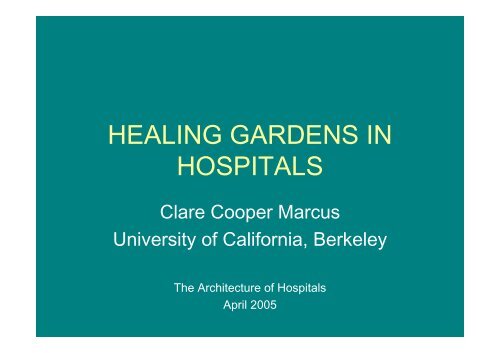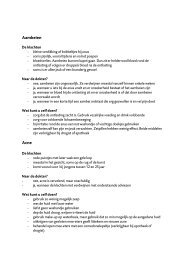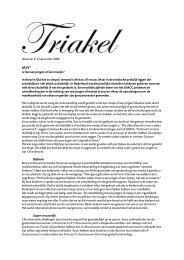HEALING GARDENS IN HOSPITALS - Umcg
HEALING GARDENS IN HOSPITALS - Umcg
HEALING GARDENS IN HOSPITALS - Umcg
You also want an ePaper? Increase the reach of your titles
YUMPU automatically turns print PDFs into web optimized ePapers that Google loves.
<strong>HEAL<strong>IN</strong>G</strong> <strong>GARDENS</strong> <strong>IN</strong><br />
<strong>HOSPITALS</strong><br />
Clare Cooper Marcus<br />
University of California, Berkeley<br />
The Architecture of Hospitals<br />
April 2005
Outline of Presentation<br />
• History of outdoor spaces in hospitals<br />
and why healing gardens have recently<br />
become of interest<br />
• Design guidelines<br />
• Precedents drawn upon by designers of<br />
contemporary healing gardens
1.MIDDLE AGES<br />
History and Recent<br />
Developments<br />
• Medieval monastic<br />
cloister garden<br />
• Early example of<br />
restorative outdoor<br />
space for sick<br />
patients
2. RENAISSANCE<br />
• 17th-18th century :<br />
Period of large<br />
municipal hospitals<br />
• Buildings surround<br />
courtyards for<br />
exercise and air<br />
circulation
3. PAVILION-STYLE <strong>HOSPITALS</strong><br />
Johns Hopkins Hospital,<br />
Baltimore<br />
• Mid-19th-early 20th<br />
century<br />
• Pavilion hospital,<br />
providing fresh air,<br />
sunlight and views<br />
to nature inspired by<br />
work of public health<br />
reformer,Florence<br />
Nightingale
3.PAVILION-STYLE <strong>HOSPITALS</strong><br />
• Early 20th century<br />
• TB sanitoria and<br />
mental asylums<br />
provide maximum<br />
exposure to sun,<br />
fresh air, and<br />
gardens to assist in<br />
healing
4. MEGA <strong>HOSPITALS</strong><br />
• Mid-20th century<br />
• Neo-classical style<br />
thrown out in favor of<br />
International Style<br />
• High rise buildings with<br />
emphasis on efficiency<br />
• Nature succumbs to<br />
cars and parking lots<br />
Nebraska Methodist Hospital,<br />
Omaha,Nebraska,USA
4. MEGA <strong>HOSPITALS</strong><br />
• 1980s<br />
• Hospitals resemble<br />
corporate office<br />
buildings<br />
• Little concern for<br />
usable outdoor<br />
space<br />
Kirklin Clinic, Birmingham, Alabama,USA
5. PATIENT CENTERED CARE<br />
Monterey Community Hospital,<br />
Monterey,California<br />
• 1990 - Present<br />
• Negative reactions to<br />
institutional<br />
environments<br />
• Competition between<br />
hospitals in US<br />
• Greater concern for<br />
patient needs<br />
• Slow shift to more<br />
welcoming , familiar<br />
imagery in interiors
5.PATIENT CENTERED CARE<br />
• Designers look to<br />
familiar icons that may<br />
feel comfortable for<br />
patients and staff<br />
• The shopping mall<br />
Dartmouth-Hitchcock Medical Center,<br />
Lebanon, New Hampshire,USA (1992)
5. PATIENT CENTERED CARE<br />
• Designers look to<br />
regional context for<br />
more appropriate<br />
styles, forms, colors<br />
and materials<br />
San Diego Children’s Hospital, San Diego,<br />
California( 1990-93)
5.PATIENT CENTERED CARE<br />
• 1984: Significant study by Roger Ulrich finds views<br />
to nature have positive influence on health outcomes<br />
• Patients recovering from gall bladder surgery with<br />
view to trees had fewer post-surgery complications,<br />
required fewer doses of strong pain drugs, went<br />
home sooner…<br />
Compared to those looking out at a brick wall<br />
• At last…credible scientific evidence that nature has<br />
healing properties
5.PATIENT CENTERED<br />
CARE<br />
St Michael’s Medical Center, Texarkana<br />
Texas<br />
• Important research by<br />
Roger Ulrich, Terry<br />
Hartig et al<br />
• Viewing - or being in -<br />
nature causes<br />
physiological and<br />
psychological changes<br />
• Body/mind returns to<br />
state of balance, and<br />
contributes to state of<br />
wholeness and health<br />
• Medical authorities see<br />
nature/trees in hospital<br />
setting as not just<br />
cosmetic extras--may<br />
speed recovery, save<br />
$$$
5.PATIENT CENTERED CARE<br />
• Hospital clients<br />
commission art with<br />
nature images<br />
Scripps Mercy Hospital,<br />
San Diego, California
5.PATIENT CENTERED CARE<br />
• Product designers<br />
create features for<br />
hospitals with nature<br />
themes
HOSPITAL GARDEN RESEARCH<br />
Roof garden, Alta Bates Hospital,<br />
Berkeley,California<br />
• 1994 - First systematic<br />
post-occupancy study<br />
of hospital outdoor<br />
space in US<br />
• 4 hospital gardens in<br />
San Francisco Bay area<br />
studied using visual<br />
analysis, behavior<br />
mapping, and<br />
interviews<br />
(Cooper Marcus and Barnes, 1994)
Sample<br />
• 2,140 people<br />
• 2,140 people<br />
observed<br />
observed<br />
• 143 people<br />
• 143 people<br />
interviewed<br />
interviewed<br />
– 73 female<br />
–73 female<br />
– 70 male<br />
–70 male<br />
patient<br />
26%<br />
User categories:<br />
visitors<br />
15%<br />
staff<br />
59%
Activities in the Gardens<br />
100%<br />
94%<br />
73% 73%<br />
68%<br />
61%<br />
50%<br />
53%<br />
38% 36%<br />
12% 11%<br />
0%<br />
Relax Eat Talk Pass by Stroll Therapy Wait Visit Play Meeting
How do you feel after<br />
spending time in the garden?<br />
• More relaxed,calmer 79%<br />
• Refreshed,stronger 25%<br />
• Able to think/cope 22%<br />
• Feel better, more positive 19%<br />
• Religious or spiritual connection 6%<br />
• No change of mood 5%
What is it about the garden<br />
that helps you feel better?<br />
• Trees,plants,nature 69%<br />
• Smells, sounds, fresh air 58%<br />
• Place to be alone or with friend 50%<br />
• Views,sub-areas,textures 26%<br />
• Practical features, benches etc 17%<br />
• Don’t know 8%
Kaiser Permanente Hospital<br />
Walnut Creek, California<br />
• Typical garden-user responses:<br />
“My level of stress goes way<br />
down..I return to work refreshed.”<br />
“I sit in the garden before my<br />
appointment; it helps me deal<br />
with what they will put me<br />
through.”<br />
“I work in the Intensive Care Unit<br />
which is like a hell hole…sitting<br />
here in the sun is like therapy for<br />
me”<br />
“I work underground in the<br />
Radiation Department, like one<br />
of the Mole People. If I didn’t<br />
have this garden to come<br />
to…sunlight, fresh air, birdsong,<br />
trees…I think I’d go CRAZY!”
5. PATIENT CENTERED CARE<br />
• Results of postoccupancy<br />
evaluations of<br />
hospital gardens,<br />
and design<br />
guidelines for future<br />
gardens, published<br />
1999
5. PATIENT CENTERED CARE<br />
Before<br />
After<br />
• Some of first healing<br />
gardens in US<br />
created by patients<br />
who saw potential of<br />
wasted space and<br />
raised money to pay<br />
for design<br />
Cancer Clinic, St Vincent’s<br />
Hospital,Santa Fe, New Mexico
5.PATIENT CENTERED CARE<br />
• American Society of<br />
Landscape Architects<br />
begins to hold special<br />
sessions on healing<br />
gardens at its annual<br />
conference<br />
• 2003 - School of Chicago<br />
Botanic Garden initiates<br />
first US course on<br />
Healthcare Garden<br />
Design
5.PATIENT CENTERED CARE<br />
• Mid 1990s: Hospital<br />
staff begin to lobby for<br />
usable outdoor spaces<br />
Before<br />
After Good Samaritan Hospital,<br />
Portland,Oregon<br />
• Horticultural therapist<br />
lead team of hospital<br />
staff, working with<br />
landscape architect, to<br />
transform dull, useless<br />
space at this hospital<br />
into vibrant garden used<br />
for physical therapy,<br />
speech therapy and<br />
horticultural therapy
Factors contributing to emergence of interest in<br />
healing gardens , beginning in 1990s<br />
• Understanding of mind-body connection<br />
• Stress reduction enhances immune function<br />
• Interest in alternative or complementary medicine<br />
• Awareness that hospitals must be not only<br />
functionally efficient, but also patient-centered /<br />
psychologically supportive<br />
• Evidence that environmental factors(light,<br />
temperature, noise, music, nature) play role in<br />
improved patient health-outcomes<br />
• Recognition(in US) that attractive environment is<br />
good marketing tool in competitive healthcare
Alternative medicine begins to be recognized by<br />
government bodies and medical schools<br />
• 1992 - Office of Alternative Medicine established<br />
within National Institutes of Health, Washington,DC<br />
• 1999 - University of Minnesota offers first U.S.<br />
graduate level courses in alternative medicine<br />
• 2005 - 26 medical schools in U.S. now offer such<br />
courses<br />
• Nature and healing no longer viewed as a “fringe”<br />
idea
THE <strong>HEAL<strong>IN</strong>G</strong> GARDEN: Essential design<br />
elements and environmental qualities<br />
Guidelines based on stress research,<br />
post occupancy studies of hospital<br />
outdoor space, and field observations<br />
at more than 100 hospital gardens in<br />
US,UK,Canada and Australia
<strong>HEAL<strong>IN</strong>G</strong> GARDEN<br />
• Facilitates stress reduction, helps body reach more<br />
balanced state<br />
• Helps person summon up own inner healing<br />
resources<br />
• Helps patient come to terms with incurable medical<br />
condition<br />
• Provides needed retreat for staff from stress of work<br />
• Provides welcome setting for visitors<br />
• Healing is not equivalent to cure<br />
• Other terms used for healing garden: therapeutic,<br />
restorative, rehabilitative
POTENTIAL ACTIVITIES <strong>IN</strong> A <strong>HEAL<strong>IN</strong>G</strong><br />
GARDEN RANGE FROM PASSIVE TO<br />
ACTIVE<br />
• Viewing garden through window<br />
• Sitting outside<br />
• Dozing/napping/meditation/prayer<br />
• Gentle rehabilitation exercises<br />
• Walking to preferred spot<br />
• Eating/reading/doing paper work outside<br />
• Taking a stroll<br />
• Child playing in garden<br />
• Raised bed gardening<br />
• Vigorous walking<br />
• Sports
What happens ,psychologically, when a person<br />
chooses to go outdoors to a garden or natural<br />
space to help themselves feel better?<br />
• Research suggests<br />
that unconsciously<br />
they may move<br />
through 3 or 4<br />
stages:<br />
• The journey<br />
• Sensory awakening<br />
• Personal centering<br />
• Spiritual attunement<br />
(Marni<br />
Barnes, 1994)
EVIDENCE-GROUNDED DESIGN THEORY:<br />
How Gardens Improve Outcomes (Ulrich,1991, 1999)<br />
EXERCISE<br />
SENSE OF<br />
CONTROL<br />
SOCIAL<br />
SUPPORT<br />
ENGAGEMENT<br />
WITH NATURE<br />
STRESS RESTORATION AND BUFFER<strong>IN</strong>G<br />
IMPROVED HEALTH OUTCOMES<br />
(Clinical outcomes, patient satisfaction,cost of care)
1. OPPORTUNITIES FOR EXERCISE<br />
• Exercise is associated<br />
with a spectrum of<br />
health benefits -<br />
especially for those who<br />
are sedentary,<br />
depressed or elderly<br />
• Even a few minutes of<br />
mild exercise improves<br />
mood, reduces stress<br />
• People are more likely<br />
to walk when there is an<br />
attractive setting to walk<br />
in; paths which<br />
encourage exploration
1.OPPORTUNITIES FOR EXERCISE: Different<br />
people seek different kinds of exercise<br />
• Opportunities for<br />
exercise for patients<br />
recovering from a<br />
stroke will be very<br />
different from…<br />
• Those for staff who<br />
want to walk or jog<br />
for health in their<br />
lunch hour
1.OPPORTUNITIES FOR EXERCISE: Different<br />
people will seek different kinds of exercise<br />
Kaiser Permanente Hospital, Vallejo, California<br />
• Well siblings run off<br />
steam in a maze<br />
outside a pediatric outpatient<br />
clinic<br />
• Labyrinths are<br />
becoming increasingly<br />
popular in U.S healing<br />
gardens<br />
• Patients, staff and<br />
visitors use for<br />
contemplative walking<br />
(Temporary labyrinth installed for healing design conference, Liverpool,UK)
2.OPPORTUNITIES TO MAKE CHOICES,<br />
SEEK PRIVACY AND EXPERIENCE A SENSE<br />
OF CONTROL<br />
• People have need for sense of control with respect<br />
to physical and social environments<br />
• On entering hospital, many experience loss of<br />
control: Institution decides…<br />
-what you eat<br />
-what you wear<br />
-when doctor visits , etc<br />
• Loss of control produces stress, worsens health<br />
outcomes<br />
• Garden can be designed to enhance sense of control
2. SENSE OF CONTROL<br />
• Being able to go<br />
outdoors,visit with<br />
friends, choose where<br />
to walk, where to sit<br />
subtly reinforces a<br />
sense of autonomy<br />
St Thomas’ Hospital, London, England
2. SENSE OF CONTROL<br />
• Something as simple as<br />
providing mobile<br />
furniture permits this<br />
nurse to move into the<br />
shade and place her<br />
lunch on the edge of a<br />
concrete planter<br />
• Staff working on tight<br />
schedules and perhaps<br />
under strict supervision<br />
can regain a measure<br />
of control in a garden<br />
Alta Bates Hospital, Berkeley, California
2.SENSE OF CONTROL<br />
Garden of St Thomas’ Hospital,<br />
London<br />
• Providing choices<br />
where people can sit -<br />
as a group or alone -<br />
can facilitate a sense of<br />
control<br />
• Locating seating with an<br />
expansive view or a<br />
close-in view, in sun or<br />
in shade, offers<br />
welcome choices<br />
St Thomas’ Hospital, London, England
3.PROVIDE SETT<strong>IN</strong>GS WHICH ENCOURAGE<br />
PEOPLE TO GATHER TOGETHER AND<br />
EXPERIENCE SOCIAL SUPPORT<br />
St George’s s Hospital, London, England<br />
Research indicates that<br />
people with higher levels of<br />
social support :<br />
-are less stressed<br />
-have better health<br />
than those who are more<br />
socially isolated<br />
Locate gardens close to<br />
patient rooms and waiting<br />
areas, with sub-spaces<br />
where people can find<br />
privacy
3.SOCIAL SUPPORT<br />
• Staff also need<br />
restorative places to<br />
converse with<br />
colleagues and find<br />
social support<br />
• Post-occupancy<br />
study in California<br />
found staff were<br />
largest users of<br />
hospital outdoor<br />
space<br />
Alta Bates Hospital, Berkeley, California
3.SOCIAL SUPPORT<br />
Kaiser Permanente Hospital, Walnut Creek, California<br />
• “It would show that they<br />
care about us, as staff<br />
in a hospital, by having<br />
a place where we can<br />
relax..” (Nurse,London<br />
hospital)<br />
• “…Public spaces that<br />
encourage interaction<br />
and communication<br />
influence staff<br />
retention.”<br />
( Survey of Nurses, Committee<br />
for Architecture and the Built<br />
Environment, UK, 2004)<br />
St Thomas’Hospital<br />
Hospital, , London, England
3.SOCIAL SUPPORT<br />
Legacy Emanuel Hospital, Portland, Oregon,USA<br />
• For people to be<br />
attracted to relax and<br />
visit with friends or<br />
family in a hospital<br />
outdoor space it must<br />
be green, quiet, and<br />
offer places of<br />
privacy…..<br />
• NOT THIS !
3.SOCIAL SUPPORT<br />
Alzheimer facility, Chemainus, , BC,Canada<br />
• In considering the need<br />
for social support - the<br />
comfort of people sitting<br />
and talking together -<br />
care must be taken in<br />
the selection of furniture<br />
• This….<br />
• NOT THIS !<br />
St Mary’s s Hospital, Isle of Wight, England
4.ENGAGEMENT WITH NATURE<br />
• A healing garden must<br />
have a profusion of green<br />
nature , which has the<br />
effect of:<br />
+ Awakening the senses<br />
+ Calming the mind<br />
+ Reducing stress<br />
+ Assisting a person to<br />
marshall their own inner<br />
healing resources<br />
• Nature cannot mend a<br />
broken leg or remove a<br />
tumor, but can support<br />
and strengthen us<br />
before/during/after<br />
medical procedures
4.ENGAGEMENT WITH NATURE<br />
• In selecting plant<br />
material, designer<br />
should consider color,<br />
texture,subtleties of<br />
green and leaf shape,<br />
grasses which more<br />
with the slightest breeze<br />
• Frail patient may move<br />
slowly, and sit for long<br />
time in one place<br />
• Planting design should<br />
be intricate, detailed<br />
and appeal to all the<br />
senses
4.ENGAGEMENT WITH NATURE<br />
• Plants and trees with distinctive seasonal changes<br />
should be considered in gardens for nursing homes,<br />
assisted living, Alzheimer’s facilities etc, where<br />
patients spend a long time and may lose track of time<br />
• Nature attracts our attention without depleting the<br />
body of energy
4.ENGAGEMENT WITH NATURE<br />
Kaiser Permanente Hospital, Vallejo California<br />
• Trees can provide<br />
metaphors of solidity,<br />
strength and<br />
permanence<br />
• Annuals can provide<br />
metaphors of growth,<br />
budding,blooming,seedng,<br />
decay, death, and<br />
transformation<br />
• Perennials can provide<br />
metaphors of<br />
persistence and<br />
renewal
4.ENGAGEMENT WITH NATURE<br />
• Our connection with<br />
nature can also be<br />
cognitive<br />
• Plant labels engage<br />
our attention and<br />
can stimulate<br />
conversation<br />
Healing Garden, Good Samaritan<br />
Hospital, Portland,Oregon
4.ENGAGEMENT WITH NATURE<br />
• Hospital outdoor space<br />
with little or no<br />
greenery will have little<br />
healing value<br />
• No amount of clever<br />
paving<br />
design,sculpture or<br />
seating can make up<br />
for lack of nature
4.ENGAGEMENT WITH NATURE<br />
Hospice, Portland, Oregon<br />
Victoria General Hospital,<br />
Victoria,BC,Canada<br />
• Architects and landscape architects must work<br />
together to ensure that there are views out to<br />
gardens and landscape from patient rooms, staff<br />
offices, and corridors for post-surgery exercise<br />
• Views to gardens and exterior landscape can assist<br />
in way-finding and reduce the stress of finding one’s<br />
way around a strange building
4.ENGAGEMENT WITH NATURE<br />
Trinity<br />
Hospice,<br />
London<br />
• Water is also an<br />
element of nature<br />
• Views of still, reflective<br />
water; sounds and<br />
views of moving water<br />
are engaging and<br />
soothing<br />
• Water attracts wildlife,<br />
reminding us in time of<br />
ill-health that life goes<br />
on<br />
West Dorset County<br />
Hospital, UK
4. ENGAGEMENT WITH NATURE<br />
Rehabilitation Hospital ,Lake Katrine, , NY, USA<br />
• Indoor gardens and<br />
atria are becoming<br />
more common in<br />
hospitals where:<br />
-no outdoor space is<br />
available<br />
-climate precludes<br />
use of outdoors for<br />
much of year<br />
Glenrose Rehabilitation Hospital, Edmonton, Alberta, Canada
5.VISIBILITY<br />
St Mary’s s Hospital,<br />
San Francisco<br />
• Designing a healing<br />
garden to provide for<br />
exercise, sense of<br />
control, social support,<br />
and engagement with<br />
nature - though all<br />
essential - is not<br />
enough<br />
• People have to know<br />
the garden is there!<br />
• Ideally, garden is visible<br />
from main lobby, so<br />
signage is not<br />
necessary
6.ACCESSIBILITY<br />
St Thomas’ Hospital, London<br />
• People of all ages and abilities need to be<br />
able to enter and move around in the garden<br />
• Paths must be wide enough for two<br />
wheelchairs to pass (minimum 6 feet)
6.ACCESSIBILITY<br />
Healing Garden,<br />
Good Samaritan Hospital,<br />
Portland, Oregon<br />
• Paths should be smooth and wide enough for a<br />
patient on a bed or gurney to be wheeled into the<br />
garden<br />
• Paving joints should be narrow enough so as not to<br />
catch a cane, the wheels of a walker or an IV-pole
6.ACCESSIBILITY<br />
West Dorset County Hospital,<br />
Dorchester ,UK<br />
St Mary’s s Hospital , Isle of Wight,<br />
UK<br />
• WHAT NOT TO DO!<br />
• Garden paved with<br />
pebbles for maternity<br />
ward<br />
• Pregnant women feared<br />
they would trip<br />
• Water/island theme of<br />
hospital interior carried<br />
to ridiculous lengths<br />
• Courtyard surface<br />
“waves” up and down;<br />
frail patients cannot use
7.FAMILIARITY<br />
St Nicholas’Hospice<br />
Hospice,<br />
W.Suffolk Hospital,<br />
England<br />
• When people are stressed, elements that are<br />
familiar in that culture are comforting - this<br />
should include the garden, its design, plants,<br />
detailing, furnishing etc
8.QUIET<br />
• People enjoy natural<br />
sounds in a hospital<br />
garden, such as a<br />
fountain,<br />
birdsong,rustling of<br />
leaves<br />
• Study of 4 California<br />
hospital gardens found<br />
people most disturbed<br />
by incongruent sounds<br />
such as air<br />
conditioner,traffic,<br />
emergency helicopter
9.COMFORT<br />
• Garden should be<br />
located close to patient<br />
areas and staff break<br />
room, with choice of<br />
seating in sun and<br />
shade, and semi-private<br />
niches where a person<br />
can feel secure<br />
Homerton Hospital,London
9.COMFORT<br />
Garden of Trinity Hospice,<br />
London<br />
• A garden shelter can provide a destination<br />
point for a walk, and offer shelter from sun,<br />
wind or rain, thus extending the use of the<br />
garden throughout the day or year
9.COMFORT<br />
• WHAT NOT TO DO!<br />
• Psychological discomfort in a courtyard<br />
surrounded with windows, no sense of<br />
privacy, feeling of being in a “fishbowl”
10.PANORAMIC VIEW<br />
San Diego Hospice,<br />
California<br />
• Where location and topography permit, a viewpoint<br />
from a garden provides a significant place for<br />
reflection<br />
• Research suggests that people who are stressed find<br />
a viewpoint soothing as it helps them to “get things<br />
into perspective”, and “see the big picture”
11. UNAMBIGUOUSLY POSITIVE ELEMENTS;<br />
Emotional Congruence Theory<br />
• Our emotional state biases our perception of the<br />
environment<br />
• A person who is fearful, and a person who is happy,<br />
may look at the same object and have very different<br />
reactions<br />
• Ambiguous or abstract features may be interpreted<br />
by stressed patients as fearful or threatening<br />
(…even if the artist had no such intention…)<br />
• Therefore…any feature that might be misinterpreted<br />
should not be located in a healing garden
Art in a Psychiatric Ward (Ulrich, 1986)<br />
• STAFF comments:<br />
“I think its fun..whimsical..”<br />
“Funny little talking apple<br />
cores…”<br />
• PATIENT comments:<br />
“Charred skulls…Drops of<br />
blood flying..”<br />
“Wounded people. They-re<br />
in pain and crying out.”
Duke Medical Center, Raleigh , North Carolina:<br />
The Bird Garden<br />
• An example of the<br />
wrong kind of art being<br />
placed in a hospital<br />
• Cancer patients, looking<br />
out onto this “garden”<br />
reacted negatively:<br />
“Beaks tearing my<br />
flesh…”<br />
“Hands coming up to<br />
grab me…”<br />
• The sculptures had to<br />
be removed
Inappropriate art in a cancer clinic garden?<br />
• These concrete-slab<br />
sculptures would be<br />
quite appropriate in<br />
a museum garden…<br />
• BUT…are they<br />
appropriate at a<br />
cancer clinic where<br />
stressed patients<br />
might interpret them<br />
as gravestones?
What art IS appropriate in a hospital?<br />
• A whale “diving”<br />
into the ground can<br />
be a whimsical<br />
feature in a<br />
playground, but…<br />
• Might patients at this<br />
psychiatric hospital<br />
interpret it as a<br />
whale committing<br />
suicide?
Art in a hospital setting needs to be<br />
UNAMBIGUOUSLY POSITIVE<br />
• This sculpture might not<br />
win an award for<br />
cutting-edge design,<br />
but…<br />
• It is entirely<br />
appropriate in a hospital<br />
setting where it may<br />
evoke positive<br />
associations and<br />
memories, and help<br />
reduce stress
PRECEDENTS DRAWN UPON BY<br />
DESIGNERS OF CONTEMPORARY <strong>HEAL<strong>IN</strong>G</strong><br />
<strong>GARDENS</strong><br />
1. Archetypal spaces<br />
2. Metaphors<br />
3. Historical precedents<br />
4. Domestic precedents<br />
5. Regional attributes<br />
6. Statement art<br />
7. Medical diagnoses
1. ARCHETYPAL SPACES<br />
Therapeutic Garden at the Institute<br />
For Child and Adolescent<br />
Development,<br />
Wellesley,Massachusetts<br />
• A garden used in<br />
the psychiatric<br />
treatment of children<br />
who have<br />
experienced severe<br />
trauma<br />
• Incorporates<br />
archetypal spaces<br />
such as hill, cave,<br />
ravine, island etc
2. METAPHORS<br />
Good Samaritan Hospital,<br />
Phoenix,Arizona<br />
• A water course is a<br />
major feature of this<br />
garden, symbolizing<br />
The Cycle of Life which<br />
begins with a low<br />
fountain-pool(birth),<br />
feeds a rocky stream<br />
(the passage of life),<br />
and ends in a<br />
contemplative pool (the<br />
end of life).
3.HISTORICAL PRECEDENTS: English<br />
strolling garden<br />
• Combination of trees,<br />
flowers, lawns,winding<br />
paths<br />
AIDS Memorial Grove, Golden<br />
Gate Park, San Francisco<br />
• Suitable in many healthcare<br />
settings since it provides 4<br />
key elements in healing<br />
garden design:<br />
- opportunities for exercise<br />
- places for privacy,sense<br />
of control<br />
- settings for social support<br />
- engagement with nature
3.HISTORICAL PRECEDENT: The courtyard<br />
Royal Devon and Exeter Hospital,<br />
Devon, England<br />
• Provides enclosed,<br />
protected space<br />
• Is clearly hospital<br />
territory; in-patients may<br />
feel comfortable there in<br />
their hospital gowns<br />
• Privacy of adjacent<br />
rooms needs to be<br />
protected<br />
• Sounds of HVAC units<br />
can be irritating
3.HISTORICAL PRECEDENT: The cloister<br />
garden<br />
12th century cloister, Santiago de<br />
Compostela, Spain<br />
• Would be an ideal model for<br />
garden in nursing home,<br />
geriatric ward etc<br />
• Smooth walking<br />
surface,sheltered<br />
seating,garden view<br />
• No contemporary examples<br />
found in N. America or UK;<br />
perhaps in Italy, Spain ?
4. DOMESTIC PRECEDENTS<br />
• Front porch or front<br />
garden facing street<br />
activity preferred by<br />
elderly people in<br />
senior housing<br />
• Older people who<br />
are not sick are<br />
faced with problem<br />
of boredom rather<br />
than stress
4.DOMESTIC PRECEDENTS<br />
• Back garden is ideal<br />
model for frail<br />
elderly or those with<br />
Alzheimer’s disease<br />
• Enclosed space<br />
feels secure and is<br />
familiar from home<br />
environment
5. REGIONAL ATTRIBUTES<br />
Leichtag Family Healing Garden,<br />
San Diego Children’s Hospital,<br />
San Diego, California<br />
• A garden which<br />
“echoes” the colors<br />
and forms of a<br />
southern California<br />
beach scene<br />
• Does the familiarity<br />
create a more<br />
soothing setting for<br />
hospitalized<br />
children?
5. REGIONAL ATTRIBUTES<br />
Harrison Memorial Hospital,<br />
Bremerton, Washington<br />
• This garden “echoes”<br />
the vegetation and<br />
landscape of local<br />
coastline<br />
• Does this make it a<br />
more healing<br />
environment?<br />
• Perhaps….Recent<br />
study in Australia found<br />
favorite art in hospital<br />
depicted familiar,local<br />
scenes
5.REGIONAL ATTRIBUTES<br />
Scottsdale Memorial Hospital,<br />
Arizona<br />
• Garden appropriate<br />
to regional desert<br />
context and to<br />
preferences of local<br />
Hispanic population<br />
• But what about<br />
preferences of<br />
retirees from northeastern<br />
USA ?
6. STATEMENT ART<br />
West Dorset County Hospital, Dorchester,<br />
England<br />
• Artist commissioned to<br />
design a hospital<br />
courtyard makes<br />
“statement” that has<br />
nothing to do with<br />
regional context and<br />
has none of the<br />
attributes of a healing<br />
space
6.STATEMENT ART<br />
Norris Cancer Center garden,<br />
University of Southern California,<br />
Los Angeles<br />
• Garden for cancer<br />
center based on<br />
Russian<br />
constructivist<br />
painting<br />
• Do steel structures<br />
and minimal planting<br />
create a healing<br />
space ?
7. MEDICAL DIAGNOSES<br />
• Hospital gardens for specific populations are<br />
now being designed to meet the medical<br />
needs of patients and their care-givers<br />
• Gardens are becoming the location of, and<br />
means of treatment for, certain patients<br />
• While some successful gardens in this<br />
category have been created, more research<br />
is needed
Healing Garden, Good Samaritan<br />
Hospital,Portland,Oregon<br />
7. MEDICAL DIAGNOSIS<br />
• REHABILITATION<br />
garden designed for<br />
physical therapists,<br />
speech pathologists, and<br />
horticultural therapists to<br />
work with patients who<br />
have had strokes,or<br />
suffered brain damage<br />
• Varied surfaces and<br />
slopes for learning to<br />
walk again<br />
• Varied planter edge<br />
heights for sitting, leaning<br />
• Variety of labeled plants<br />
for color and shape<br />
recognition, reading etc
Before<br />
7. MEDICAL DIAGNOSIS<br />
• Before and after views<br />
of a rooftop garden for<br />
HIV/AIDS patients<br />
After<br />
• Special attention to<br />
levels of shade because<br />
patients on certain<br />
medications must not<br />
be in sun<br />
Joel Schapner Memorial<br />
Garden,Cardinal Cook<br />
Hospital,New York City
7. MEDICAL DIAGNOSIS<br />
Cancer Clinic Garden, Mount Zion<br />
Hospital, San Francisco,California<br />
• Courtyard garden at a<br />
CANCER clinic with<br />
soothing sound of<br />
water, engaging plant<br />
material, and varied<br />
degrees of shade<br />
because patients on<br />
chemotherapy drugs<br />
must stay out of sun<br />
• Cancer patients and<br />
relatives at workshop to<br />
inscribe their stories on<br />
tiles to decorate corridor<br />
beside garden
The Lodge at Broadmead,Victoria,BC,Canada<br />
Chemainus Health Care Center,Chemainus,<br />
BC, Canada<br />
7.MEDICAL DIAGNOSIS<br />
• Garden-courtyards for<br />
patients with<br />
ALZHEIMER’S<br />
DISEASE<br />
• Looped pathway to aid<br />
orientation<br />
• Tinted concrete to<br />
reduce glare<br />
• Low planting for<br />
stooped posture<br />
• Non-toxic plants<br />
• Features to evoke<br />
earlier memories:<br />
prairie grass and<br />
garden shed
7. MEDICAL DIAGNOSIS<br />
Prouty Terrace and Garden,<br />
Children’s Hospital, Boston,<br />
Massachusetts<br />
• Garden at a children’s<br />
hospital must provide<br />
for sometimes<br />
conflicting needs of sick<br />
children, well siblings,<br />
worried or grieving<br />
parents, and stressedout<br />
staff
7. MEDICAL DIAGNOSIS<br />
Rusk Institute of Rehabilitative<br />
Medicine, New York<br />
• Garden/playground for<br />
children with BRA<strong>IN</strong><br />
<strong>IN</strong>JURIES/mobility<br />
problems designed to<br />
encourage physical<br />
activity and re-use of<br />
limbs<br />
• Range of topography,<br />
surfaces,features to<br />
manipulate<br />
• Encourages interaction<br />
with natural world, and<br />
taking risks
7. MEDICAL DIAGNOSIS<br />
• Garden for children<br />
with severe<br />
HANDICAPS who<br />
live at home or in a<br />
hospital and come<br />
to facility each day<br />
Sensory Garden , Lucas Gardens<br />
School, Canada Bay, Sydney,<br />
Australia
7. MEDICAL DIAGNOSIS<br />
Legacy Burn Center Garden,<br />
Legacy Emanuel Hospital,<br />
Portland,Oregon<br />
• Garden for BURN<br />
PATIENTS and families<br />
• Paths wide enough for<br />
beds<br />
• Shade is essential<br />
• Grade changes to<br />
practice walking<br />
• Different textures for<br />
touch<br />
• Separate,private staff<br />
area
7. MEDICAL DIAGNOSIS<br />
• Garden for patients in<br />
DRUG AND ALCOHOL<br />
rehabilitation unit based<br />
on 12-Step Alcoholics<br />
Anonymous program<br />
• Each step a different<br />
sub-space in garden with<br />
inspiring words inscribed<br />
on paving stone<br />
Serenity Garden, Drug and Alcohol<br />
Rehabilitation Center, Scripps<br />
Memorial Hospital, San Diego,<br />
California
SUMMARY OF <strong>HEAL<strong>IN</strong>G</strong> GARDEN DESIGN<br />
CONSIDERATIONS<br />
Supportive of stress reduction and healing:<br />
• Convenient way-finding to garden<br />
• Accessibility<br />
• Places of privacy<br />
• Seating encouraging interaction<br />
• Contact with nature (green vegetation,nature<br />
sounds,wildlife)<br />
Hindering stress reduction and healing:<br />
• Predominance of hardscape<br />
• Ambiguous, abstract art<br />
• Intrusive mechanical sounds<br />
• Lack of privacy, places to sit<br />
• Lack of choice<br />
• Lack of shade<br />
• Feeling of insecurity or risk<br />
• Crowding<br />
• Cigarette smoke
GARDEN OFFERS COMPLETE CONTRAST<br />
TO HOSPITAL <strong>IN</strong>TERIOR<br />
HOSPITAL <strong>IN</strong>TERIOR<br />
• Institutional scale<br />
• Man-made<br />
• Evoking anxiety<br />
• Limited sensory detail<br />
• Straight lines,ordered<br />
• Controlled air<br />
• Few places to be alone<br />
• Not conducive to calming<br />
the mind<br />
• Evoking thoughts of<br />
illness,death<br />
GARDEN<br />
• Domestic scale<br />
• Natural<br />
• Evoking good memories<br />
• Rich,sensory detail<br />
• Varied shapes,organic<br />
• Fresh air<br />
• Places to be alone<br />
• Conducive to positive<br />
feelings, introspection<br />
• Links to wider world of<br />
nature, on-going cycle<br />
of life
ADVANTAGES TO HEALTHCARE FACILITIES<br />
( Roger Ulrich, 1999)<br />
PROBABLE ADVANTAGES<br />
• Reduction of stress in patients,staff and visitors (very likely)<br />
• Reduced pain in patients(likely)<br />
• Reduction in depression (likely, especially if garden fosters<br />
exercise)<br />
• Higher reported quality of life for chronic and terminally-ill<br />
patients(likely, especially if garden fosters exercise)<br />
• Improved way-finding( very likely, especially if garden in<br />
prominent location)<br />
POTENTIAL ADVANTAGES<br />
• Reduced costs : Length of stay shorter for certain patient<br />
categories; fewer strong pain medication doses<br />
• Increased patient mobility and independence<br />
• Higher patient satisfaction<br />
• Increased staff job satisfaction
MANY UNANSWERED QUESTIONS…<br />
• Do people seeking calmness and peace in a<br />
hospital garden prefer a winding path,<br />
encouraging exploration? Or a straight path<br />
where they can see their destination?<br />
• Does it depend on the type of facility?<br />
• Does it depend on culture?
MANY UNANSWERED QUESTIONS…<br />
Good Samaritan<br />
Hospital,Phoenix<br />
Arizona<br />
• Does this Native<br />
American family find<br />
comfort in the fact that<br />
all the plants in this<br />
garden are used in<br />
traditional healing?<br />
• Are patients at this<br />
heart hospital troubled<br />
by a fountain-sculpture<br />
shaped like the human<br />
heart sliced in half, and<br />
pulsing at the rate of a<br />
normal heart-beat?<br />
Royal Brompton Heart and Lung Hospital,<br />
London
MANY UNANSWERED QUESTIONS<br />
• Do people find solace and<br />
peace in a zen garden,<br />
even when they don’t<br />
understand its symbolism?<br />
• Do the residents of this<br />
London nursing home<br />
spend time in this<br />
courtyard based on a<br />
Persian paradise motif, or<br />
would they have preferred<br />
an English cottage garden<br />
like the one they left at<br />
home?
TOO MANY WASTED OPPORTUNITIES<br />
• Courtyard designed by artists fulfills none of the<br />
requirements of a healing garden (Royal Devon and Exeter<br />
Hospital, England)<br />
• “Front lawn” of a children’s hospital surrounded by<br />
traffic streets is not suitable for well or sick children<br />
• (Children’s Hospital, Los Angeles, California)
DO ARCHITECTS HAVE TOO MUCH<br />
CONTROL ?<br />
• Architects often“think”<br />
via big, computer-drawn<br />
models<br />
• Outdoor space<br />
sometimes perceived<br />
as “…what separates<br />
buildings…”<br />
• Architect may design<br />
outdoor space; does not<br />
have appropriate<br />
training<br />
• Landscape architect<br />
brought into design<br />
process too late<br />
• Minimal budget to<br />
create gardens
IDEALLY, THIS SHOULD HAPPEN:<br />
• Designers work as team with medical personnel likely<br />
to use garden for therapy, and with potential patientusers<br />
• Lead professional on team is landscape architect<br />
• Team annotates plans with presumed health benefits<br />
• Post occupancy evaluation conducted after garden in<br />
use<br />
• Research results disseminated to peers<br />
• Information on garden benefits disseminated to<br />
hospital staff
Clearly more research is<br />
needed but we cannot wait<br />
until such studies are<br />
completed. The evidence<br />
we DO have warrants our<br />
continuing efforts to<br />
establish healing gardens so<br />
that users may benefit, and<br />
researchers have more<br />
possibilities of evaluating<br />
their success.
WE MUST DO BETTER THAN THIS !<br />
Royal Alexandra Children’s s Hospital, Sydney<br />
Australia<br />
St Rose Hospital, Las Vegas, Nevada<br />
• Fads and fashions in design lead to hospital outdoor<br />
space that fulfills none of the needs of a healing<br />
garden<br />
• “Stripes” of granite and gravel, lawn and<br />
gravel….anything striped = current fashion in<br />
landscape architecture
WE MUST DO BETTER THAN THIS<br />
• Staff who work in this<br />
kind of milieu deserve THIS<br />
a place where they can<br />
take a break that is<br />
better than…
WE MUST DO BETTER THAN THIS !<br />
Mental Health Clinic, Miami,Florida<br />
Mt. Sinai Hospital, Toronto, Canada<br />
• A path that runs through a bench and terminates in a<br />
wall: What sort of message is that for a patient with a<br />
mental illness?<br />
• Dying plants at the entrance to a hospital…”If they can’t<br />
keep the plants alive, how will they care for me ?!…”
















